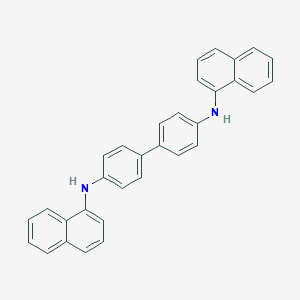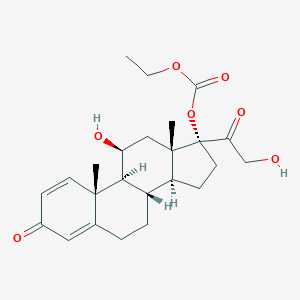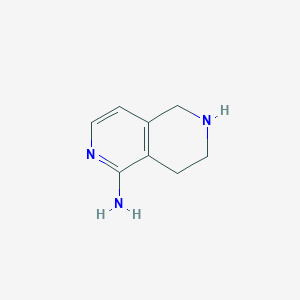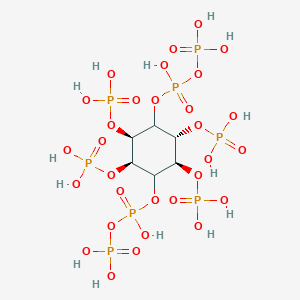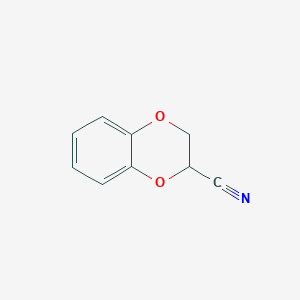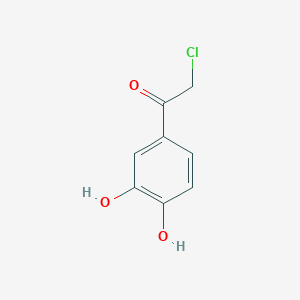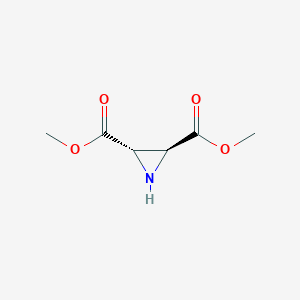
(S)-(+)-Mandelic acid
Vue d'ensemble
Description
L’acide mandélique est un acide α-hydroxy aromatique de formule moléculaire C₆H₅CH(OH)CO₂H. Il se présente sous la forme d’un solide cristallin blanc soluble dans l’eau et les solvants organiques polaires. Le composé a été découvert en 1831 par le pharmacien allemand Ferdinand Ludwig Winckler lors du chauffage de l’amygdaline, un extrait d’amandes amères, avec de l’acide chlorhydrique dilué. Le nom « mandélique » dérive du mot allemand « Mandel », qui signifie amande .
Méthodes De Préparation
L’acide mandélique est généralement préparé par hydrolyse acidocatalysée du mandélonitrile, qui est la cyanhydrine du benzaldéhyde. Le mandélonitrile peut être synthétisé par réaction du benzaldéhyde avec le bisulfite de sodium pour former l’adduit correspondant, qui est ensuite traité avec du cyanure de sodium et hydrolysé . Industriellement, l’acide mandélique peut également être produit par hydrolyse basique de l’acide phénylchloroacétique ou de la dibromacétophénone . De plus, il peut être obtenu par chauffage du phénylglyoxal avec des alcalis .
Analyse Des Réactions Chimiques
L’acide mandélique subit diverses réactions chimiques, notamment :
Oxydation : L’acide mandélique peut être oxydé en acide benzoylformique en utilisant des agents oxydants tels que le permanganate de potassium.
Réduction : Il peut être réduit en acide phénylglycolique en utilisant des agents réducteurs comme le borohydrure de sodium.
Substitution : L’acide mandélique peut subir des réactions de substitution, telles que l’estérification avec des alcools en présence de catalyseurs acides pour former des esters.
Hydrolyse : L’hydrolyse du mandélonitrile en acide mandélique est une réaction courante, généralement réalisée en milieu acide.
Applications De Recherche Scientifique
L’acide mandélique a un large éventail d’applications en recherche scientifique :
Chimie : Il est utilisé comme agent de résolution chirale et comme précurseur dans la synthèse de divers produits pharmaceutiques.
Biologie : L’acide mandélique est impliqué dans la voie du mandélate, une série de réactions biochimiques chez certaines bactéries.
Médecine : Il est utilisé en dermatologie pour ses propriétés exfoliantes, antibactériennes et anti-inflammatoires.
Mécanisme D'action
L’acide mandélique agit en brisant les liaisons entre les cellules de la peau, ce qui conduit à un taux accru de renouvellement cellulaire. Ce mécanisme est bénéfique pour exfolier la peau et traiter des affections telles que l’acné, l’hyperpigmentation et les rides . Dans la voie du mandélate, des enzymes telles que la racémase du mandélate et la déshydrogénase du mandélate catalysent la conversion de l’acide mandélique en d’autres intermédiaires, facilitant sa dégradation et son utilisation dans le métabolisme bactérien .
Comparaison Avec Des Composés Similaires
L’acide mandélique est souvent comparé à d’autres acides α-hydroxy tels que l’acide glycolique et l’acide lactique. Contrairement à l’acide glycolique, qui a une taille moléculaire plus petite et pénètre plus rapidement dans la peau, l’acide mandélique a une taille moléculaire plus grande, ce qui se traduit par une pénétration plus lente et une irritation réduite . Des composés similaires incluent :
Acide glycolique : Connu pour ses fortes propriétés exfoliantes.
Acide lactique : Un autre acide α-hydroxy avec des avantages similaires à ceux de l’acide mandélique.
Acide citrique : Utilisé dans les soins de la peau pour ses propriétés exfoliantes et antioxydantes.
Les propriétés uniques de l’acide mandélique, telles que ses effets antibactériens et anti-inflammatoires, le rendent particulièrement adapté aux peaux sensibles et au traitement d’une variété d’affections dermatologiques .
Propriétés
IUPAC Name |
2-hydroxy-2-phenylacetic acid | |
|---|---|---|
| Source | PubChem | |
| URL | https://pubchem.ncbi.nlm.nih.gov | |
| Description | Data deposited in or computed by PubChem | |
InChI |
InChI=1S/C8H8O3/c9-7(8(10)11)6-4-2-1-3-5-6/h1-5,7,9H,(H,10,11) | |
| Source | PubChem | |
| URL | https://pubchem.ncbi.nlm.nih.gov | |
| Description | Data deposited in or computed by PubChem | |
InChI Key |
IWYDHOAUDWTVEP-UHFFFAOYSA-N | |
| Source | PubChem | |
| URL | https://pubchem.ncbi.nlm.nih.gov | |
| Description | Data deposited in or computed by PubChem | |
Canonical SMILES |
C1=CC=C(C=C1)C(C(=O)O)O | |
| Source | PubChem | |
| URL | https://pubchem.ncbi.nlm.nih.gov | |
| Description | Data deposited in or computed by PubChem | |
Molecular Formula |
C8H8O3 | |
| Source | PubChem | |
| URL | https://pubchem.ncbi.nlm.nih.gov | |
| Description | Data deposited in or computed by PubChem | |
Related CAS |
32518-00-6, Array | |
| Record name | Poly(mandelic acid) | |
| Source | CAS Common Chemistry | |
| URL | https://commonchemistry.cas.org/detail?cas_rn=32518-00-6 | |
| Description | CAS Common Chemistry is an open community resource for accessing chemical information. Nearly 500,000 chemical substances from CAS REGISTRY cover areas of community interest, including common and frequently regulated chemicals, and those relevant to high school and undergraduate chemistry classes. This chemical information, curated by our expert scientists, is provided in alignment with our mission as a division of the American Chemical Society. | |
| Explanation | The data from CAS Common Chemistry is provided under a CC-BY-NC 4.0 license, unless otherwise stated. | |
| Record name | Mandelic acid [USP] | |
| Source | ChemIDplus | |
| URL | https://pubchem.ncbi.nlm.nih.gov/substance/?source=chemidplus&sourceid=0000090642 | |
| Description | ChemIDplus is a free, web search system that provides access to the structure and nomenclature authority files used for the identification of chemical substances cited in National Library of Medicine (NLM) databases, including the TOXNET system. | |
DSSTOX Substance ID |
DTXSID6023234 | |
| Record name | Mandelic acid | |
| Source | EPA DSSTox | |
| URL | https://comptox.epa.gov/dashboard/DTXSID6023234 | |
| Description | DSSTox provides a high quality public chemistry resource for supporting improved predictive toxicology. | |
Molecular Weight |
152.15 g/mol | |
| Source | PubChem | |
| URL | https://pubchem.ncbi.nlm.nih.gov | |
| Description | Data deposited in or computed by PubChem | |
Physical Description |
Liquid; Pellets or Large Crystals, Solid; Darkens and decomposes after prolonged light exposure; [Merck Index] White crystalline powder with a faint sweet odor; [Fisher Scientific MSDS] | |
| Record name | Benzeneacetic acid, .alpha.-hydroxy- | |
| Source | EPA Chemicals under the TSCA | |
| URL | https://www.epa.gov/chemicals-under-tsca | |
| Description | EPA Chemicals under the Toxic Substances Control Act (TSCA) collection contains information on chemicals and their regulations under TSCA, including non-confidential content from the TSCA Chemical Substance Inventory and Chemical Data Reporting. | |
| Record name | Mandelic acid | |
| Source | Haz-Map, Information on Hazardous Chemicals and Occupational Diseases | |
| URL | https://haz-map.com/Agents/15358 | |
| Description | Haz-Map® is an occupational health database designed for health and safety professionals and for consumers seeking information about the adverse effects of workplace exposures to chemical and biological agents. | |
| Explanation | Copyright (c) 2022 Haz-Map(R). All rights reserved. Unless otherwise indicated, all materials from Haz-Map are copyrighted by Haz-Map(R). No part of these materials, either text or image may be used for any purpose other than for personal use. Therefore, reproduction, modification, storage in a retrieval system or retransmission, in any form or by any means, electronic, mechanical or otherwise, for reasons other than personal use, is strictly prohibited without prior written permission. | |
Vapor Pressure |
0.0000164 [mmHg] | |
| Record name | Mandelic acid | |
| Source | Haz-Map, Information on Hazardous Chemicals and Occupational Diseases | |
| URL | https://haz-map.com/Agents/15358 | |
| Description | Haz-Map® is an occupational health database designed for health and safety professionals and for consumers seeking information about the adverse effects of workplace exposures to chemical and biological agents. | |
| Explanation | Copyright (c) 2022 Haz-Map(R). All rights reserved. Unless otherwise indicated, all materials from Haz-Map are copyrighted by Haz-Map(R). No part of these materials, either text or image may be used for any purpose other than for personal use. Therefore, reproduction, modification, storage in a retrieval system or retransmission, in any form or by any means, electronic, mechanical or otherwise, for reasons other than personal use, is strictly prohibited without prior written permission. | |
CAS No. |
90-64-2, 611-72-3 | |
| Record name | Mandelic acid | |
| Source | CAS Common Chemistry | |
| URL | https://commonchemistry.cas.org/detail?cas_rn=90-64-2 | |
| Description | CAS Common Chemistry is an open community resource for accessing chemical information. Nearly 500,000 chemical substances from CAS REGISTRY cover areas of community interest, including common and frequently regulated chemicals, and those relevant to high school and undergraduate chemistry classes. This chemical information, curated by our expert scientists, is provided in alignment with our mission as a division of the American Chemical Society. | |
| Explanation | The data from CAS Common Chemistry is provided under a CC-BY-NC 4.0 license, unless otherwise stated. | |
| Record name | Mandelic acid [USP] | |
| Source | ChemIDplus | |
| URL | https://pubchem.ncbi.nlm.nih.gov/substance/?source=chemidplus&sourceid=0000090642 | |
| Description | ChemIDplus is a free, web search system that provides access to the structure and nomenclature authority files used for the identification of chemical substances cited in National Library of Medicine (NLM) databases, including the TOXNET system. | |
| Record name | Mandelic acid | |
| Source | DrugBank | |
| URL | https://www.drugbank.ca/drugs/DB13218 | |
| Description | The DrugBank database is a unique bioinformatics and cheminformatics resource that combines detailed drug (i.e. chemical, pharmacological and pharmaceutical) data with comprehensive drug target (i.e. sequence, structure, and pathway) information. | |
| Explanation | Creative Common's Attribution-NonCommercial 4.0 International License (http://creativecommons.org/licenses/by-nc/4.0/legalcode) | |
| Record name | MANDELIC ACID | |
| Source | DTP/NCI | |
| URL | https://dtp.cancer.gov/dtpstandard/servlet/dwindex?searchtype=NSC&outputformat=html&searchlist=7925 | |
| Description | The NCI Development Therapeutics Program (DTP) provides services and resources to the academic and private-sector research communities worldwide to facilitate the discovery and development of new cancer therapeutic agents. | |
| Explanation | Unless otherwise indicated, all text within NCI products is free of copyright and may be reused without our permission. Credit the National Cancer Institute as the source. | |
| Record name | Benzeneacetic acid, .alpha.-hydroxy- | |
| Source | EPA Chemicals under the TSCA | |
| URL | https://www.epa.gov/chemicals-under-tsca | |
| Description | EPA Chemicals under the Toxic Substances Control Act (TSCA) collection contains information on chemicals and their regulations under TSCA, including non-confidential content from the TSCA Chemical Substance Inventory and Chemical Data Reporting. | |
| Record name | Mandelic acid | |
| Source | EPA DSSTox | |
| URL | https://comptox.epa.gov/dashboard/DTXSID6023234 | |
| Description | DSSTox provides a high quality public chemistry resource for supporting improved predictive toxicology. | |
| Record name | Mandelic acid | |
| Source | European Chemicals Agency (ECHA) | |
| URL | https://echa.europa.eu/substance-information/-/substanceinfo/100.001.825 | |
| Description | The European Chemicals Agency (ECHA) is an agency of the European Union which is the driving force among regulatory authorities in implementing the EU's groundbreaking chemicals legislation for the benefit of human health and the environment as well as for innovation and competitiveness. | |
| Explanation | Use of the information, documents and data from the ECHA website is subject to the terms and conditions of this Legal Notice, and subject to other binding limitations provided for under applicable law, the information, documents and data made available on the ECHA website may be reproduced, distributed and/or used, totally or in part, for non-commercial purposes provided that ECHA is acknowledged as the source: "Source: European Chemicals Agency, http://echa.europa.eu/". Such acknowledgement must be included in each copy of the material. ECHA permits and encourages organisations and individuals to create links to the ECHA website under the following cumulative conditions: Links can only be made to webpages that provide a link to the Legal Notice page. | |
| Record name | DL-2-hydroxy-2-phenylacetic acid | |
| Source | European Chemicals Agency (ECHA) | |
| URL | https://echa.europa.eu/substance-information/-/substanceinfo/100.009.344 | |
| Description | The European Chemicals Agency (ECHA) is an agency of the European Union which is the driving force among regulatory authorities in implementing the EU's groundbreaking chemicals legislation for the benefit of human health and the environment as well as for innovation and competitiveness. | |
| Explanation | Use of the information, documents and data from the ECHA website is subject to the terms and conditions of this Legal Notice, and subject to other binding limitations provided for under applicable law, the information, documents and data made available on the ECHA website may be reproduced, distributed and/or used, totally or in part, for non-commercial purposes provided that ECHA is acknowledged as the source: "Source: European Chemicals Agency, http://echa.europa.eu/". Such acknowledgement must be included in each copy of the material. ECHA permits and encourages organisations and individuals to create links to the ECHA website under the following cumulative conditions: Links can only be made to webpages that provide a link to the Legal Notice page. | |
| Record name | MANDELIC ACID | |
| Source | FDA Global Substance Registration System (GSRS) | |
| URL | https://gsrs.ncats.nih.gov/ginas/app/beta/substances/NH496X0UJX | |
| Description | The FDA Global Substance Registration System (GSRS) enables the efficient and accurate exchange of information on what substances are in regulated products. Instead of relying on names, which vary across regulatory domains, countries, and regions, the GSRS knowledge base makes it possible for substances to be defined by standardized, scientific descriptions. | |
| Explanation | Unless otherwise noted, the contents of the FDA website (www.fda.gov), both text and graphics, are not copyrighted. They are in the public domain and may be republished, reprinted and otherwise used freely by anyone without the need to obtain permission from FDA. Credit to the U.S. Food and Drug Administration as the source is appreciated but not required. | |
Synthesis routes and methods I
Procedure details





Synthesis routes and methods II
Procedure details





Retrosynthesis Analysis
AI-Powered Synthesis Planning: Our tool employs the Template_relevance Pistachio, Template_relevance Bkms_metabolic, Template_relevance Pistachio_ringbreaker, Template_relevance Reaxys, Template_relevance Reaxys_biocatalysis model, leveraging a vast database of chemical reactions to predict feasible synthetic routes.
One-Step Synthesis Focus: Specifically designed for one-step synthesis, it provides concise and direct routes for your target compounds, streamlining the synthesis process.
Accurate Predictions: Utilizing the extensive PISTACHIO, BKMS_METABOLIC, PISTACHIO_RINGBREAKER, REAXYS, REAXYS_BIOCATALYSIS database, our tool offers high-accuracy predictions, reflecting the latest in chemical research and data.
Strategy Settings
| Precursor scoring | Relevance Heuristic |
|---|---|
| Min. plausibility | 0.01 |
| Model | Template_relevance |
| Template Set | Pistachio/Bkms_metabolic/Pistachio_ringbreaker/Reaxys/Reaxys_biocatalysis |
| Top-N result to add to graph | 6 |
Feasible Synthetic Routes
Q1: What is the molecular formula and weight of (S)-mandelic acid?
A1: (S)-Mandelic acid has the molecular formula C8H8O3 and a molecular weight of 152.15 g/mol.
Q2: What spectroscopic techniques are typically used to characterize (S)-mandelic acid?
A2: Researchers utilize various spectroscopic techniques to characterize (S)-mandelic acid, including:
- Nuclear Magnetic Resonance (NMR) spectroscopy: This technique provides detailed information about the compound's structure and stereochemistry. Researchers have employed 1H NMR to determine enantiomeric excess using chiral solvating agents like (S)-mandelic acid. []
- Circular Dichroism (CD) spectroscopy: This technique is specifically used to analyze chiral molecules like (S)-mandelic acid, providing insights into their absolute configuration and interactions with other chiral molecules. [, , ]
Q3: How stable is (S)-mandelic acid under different conditions?
A3: (S)-Mandelic acid exhibits varying stability depending on the environmental conditions:
- Aqueous solutions: (S)-Mandelonitrile, a precursor to (S)-mandelic acid, exhibits improved stability in acidic aqueous solutions (pH < 5), mitigating spontaneous chemical hydrocyanation. []
- Temperature and pressure: Research indicates that the conglomerate form of (S)-mandelic acid (crystals of separated enantiomers) becomes more stable than the racemic compound at higher pressures (approximately 0.64 GPa) and temperatures (460 K). []
Q4: What are the key catalytic applications of (S)-mandelic acid and its derivatives?
A4: (S)-Mandelic acid and its derivatives play crucial roles in various catalytic applications:
- Chiral resolving agents: (S)-Mandelic acid effectively resolves racemic mixtures of amines and amino alcohols, yielding enantiomerically pure compounds. [, , , , ]
- Chiral auxiliaries: Derivatives like (S)-mandelic acid esters act as efficient chiral auxiliaries in asymmetric synthesis, inducing diastereoselectivity in reactions like alkylations. [, , , ]
- Chiral templates: (S)-Mandelic acid acts as a template for creating chiral cavities in materials like mesoporous platinum. This allows for enantioselective recognition and differentiation of chiral molecules. []
Q5: Can you provide an example of (S)-mandelic acid's use in enzymatic reactions?
A5: (S)-Mandelic acid serves as a substrate in the enzymatic resolution of racemic mandelic acid using immobilized lipases. This method offers a sustainable approach to obtaining enantiomerically pure (S)-mandelic acid and (R)-mandelamide. []
Q6: How is computational chemistry employed in research related to (S)-mandelic acid?
A6: Computational chemistry tools aid in understanding the properties and behavior of (S)-mandelic acid:
- Molecular modeling: Researchers use molecular modeling to study the enantiospecific interactions of (S)-mandelic acid derivatives with chiral solutes, providing insights into observed asymmetric behavior. []
- Density functional theory (DFT) calculations: These calculations help predict vibrational properties, such as IR and VCD spectra, for (S)-mandelic acid derivatives, assisting in stereochemical assignments. []
Q7: How do structural modifications of (S)-mandelic acid affect its activity?
A7: Modifying the structure of (S)-mandelic acid can significantly impact its properties and applications:
- Esterification: Short-chain esters of (S)-mandelic acid, like (S)-n-propyl mandelate and (S)-isopropyl mandelate, exhibit distinct asymmetric behavior due to specific chiral interactions with solutes. []
- Introduction of substituents: Modifying the phenyl ring of (S)-mandelic acid with halogens or hydroxyl groups can alter its binding affinity and selectivity towards specific targets. [, , ]
Avertissement et informations sur les produits de recherche in vitro
Veuillez noter que tous les articles et informations sur les produits présentés sur BenchChem sont destinés uniquement à des fins informatives. Les produits disponibles à l'achat sur BenchChem sont spécifiquement conçus pour des études in vitro, qui sont réalisées en dehors des organismes vivants. Les études in vitro, dérivées du terme latin "in verre", impliquent des expériences réalisées dans des environnements de laboratoire contrôlés à l'aide de cellules ou de tissus. Il est important de noter que ces produits ne sont pas classés comme médicaments et n'ont pas reçu l'approbation de la FDA pour la prévention, le traitement ou la guérison de toute condition médicale, affection ou maladie. Nous devons souligner que toute forme d'introduction corporelle de ces produits chez les humains ou les animaux est strictement interdite par la loi. Il est essentiel de respecter ces directives pour assurer la conformité aux normes légales et éthiques en matière de recherche et d'expérimentation.

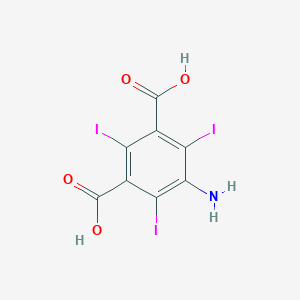
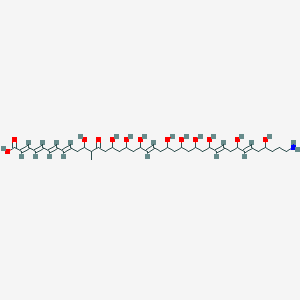
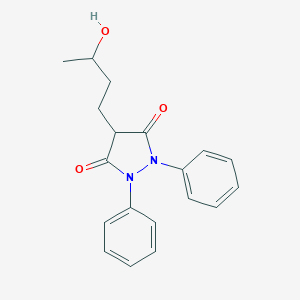
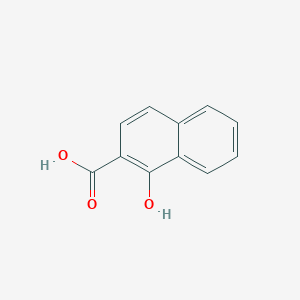
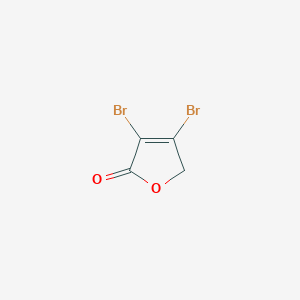
![(3aR,5S,6S,6aR)-6-hydroxy-2,2-dimethyl-3a,5,6,6a-tetrahydrofuro[2,3-d][1,3]dioxole-5-carbaldehyde](/img/structure/B119100.png)
![3-Hydroxythieno[2,3-b]pyridine-2-carbonitrile](/img/structure/B119101.png)
